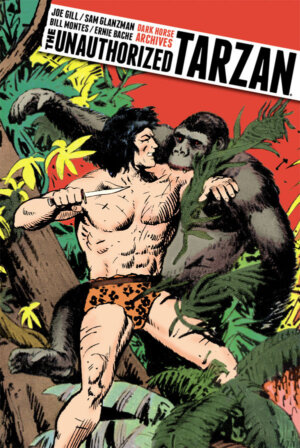
Publisher: Dark Horse Comics
Writer: Joe Gill
Pencils: Sam J. Glanzman and Bill Montes
Inkers: Sam J. Glanzman and Ernie Bache
Pages: 112
Format: Hardcover
Retail Price: $29.99 with a limited edition of 250 copies featuring a tip-in signed by Glanzman available for $59.99
Release Date: March 20th
From Dark Horse:
A classic run of Tarzan comics, reprinted for the first time! In the 1960s, believing Tarzan to have fallen into the public domain, Charlton Comics enlisted Joe Gill (Flash Gordon, House of Mystery) and Sam Glanzman (Hercules, Our Army at War) to create a new comics version of the Lord of the Jungle. Only four issues were produced before Charlton was forced to end the series, and much of the original print runs were destroyed. Collects Chalton’s Jungle Tales of Tarzan #1–#4.
* Includes never-before-seen Tarzan comic strips by Glanzman and historical essays by Roger Broughton!
The first thing you notice when you crack open this beautiful book is that you’re looking at is right on the cusp of old-style 1960’s comic sensibilities and later experimental artwork, partly pioneered by the artist in question, Sam Glanzman. Yes, you have the rock solid rectangular panels and straightforward, non-stylized backgrounds, but you also have clever perspectives and mood shadings, and the interesting choice to not have a single word balloon. The artwork is intensely detailed; the animals and the jungles are fully realized – we’re talking Mark Trail close-up quality here – and the human figures are given a lot of subtle nuances. The only real cringe-worthy moments are the depiction of black African tribes; although it’s not terrible, some of the visuals are…unfortunate, especially in “The Nightmare” from the third issue, although since most of that story is essentially a bizarre acid trip via rotten elephant meat, I can overlook it.
There are three text pieces by current Charlton head Roger Broughton to round out the collection. The first, a typical making-of piece is of mild interest as it tells the story of how the collection was put together. The second is a much more fascinating piece about the rise and fall of the four-issue Charlton collection, including how its legacy affected not only the Dell Tarzan comic, but the business practices of Charlton itself. The final piece, however, is the gold mine, with the story of the abandoned and largely unknown Tarzan comic strip Charlton was planning to do before the hammer came down. Since the Burroughs company never actually knew about the strips, they weren’t able to take and destroy them, and Glanzman had them in a manila folder in his office for decades, only now seeing the light of day. Fun stuff!